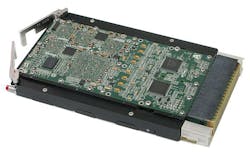Unmanned vehicles are among most promising market opportunities for embedded computing
NEW ORLEANS –Unmanned vehicles designed to operate on land, at sea, and in the air represent one of the most promising market opportunities for embedded computing technology over the next 10 years, says one market researcher.
Unmanned aircraft, unmanned ground vehicles (UGVs), and unmanned sea vehicles all will see substantial growth over the next decade, and are prime candidates for embedded computing, says Brian Arbuckle, senior market analyst at market researcher IHS Markit in London.
Arbuckle made his comments this week in a presentation at the Embedded Tech Trends (ETT) conference in New Orleans, which is sponsored by the VITA Open Standards and Open Markets industry trade group in Fountain Hills, Ariz.
From now until 2026 about 63,000 new unmanned aerial vehicles (UAVs) will be built for global military forces, 30,000 military unmanned ground vehicles with extended mission endurance in hostile environments will be built, and about 2,000 unmanned sea vehicles will be provided to global militaries, Arbuckle told ETT attendees.
For embedded computing suppliers, unmanned vehicles radar signal processing, electronic warfare (EW), and signals intelligence applications will be bright spots for design-ins of single-board computers, small-form-factor embedded computing systems, and other embedded computing technologies.
Nevertheless, many questions remain to be answered before embedded computing suppliers can be assured of these kinds of promising market opportunities, Arbuckle says -- particularly as the new U.S. President Donald Trump moves forward with his fresh administration.
"The big question will be what will the new administration do with defense spending," Arbuckle told ETT attendees. Recent studies, he points out, project U.S. defense spending to remain flat at about $600 billion annually from 2015 to 2021 -- well past Trump's first term in office.
"The Trump factor is a risk factor to this forecast," Arbuckle told conference attendees. "Will there be policy changes to increase defense spending? I suspect there will be. Is NATO obsolete? What's going to happen I couldn't even guess."
For embedded computing suppliers over the next decade, military and industrial-control applications will represent the most promising markets, Arbuckle says.
For embedded computing form factors, Arbuckle says he expects applications growth in 6U and 3U VPX embedded computing design-ins, while traditional VME applications will see contraction.
Additional embedded computing market growth over the next 10 years will occur in Computer on Module (COM) architectures, as well as in standard single-board computers.
Poor growth, however, is expected in applications of the xTCA subset of Advanced Telecommunications Computing Architecture (ATCA) in embedded computing involving physics applications over the next decade, Arbuckle says. "The xTCA market really is collapsing, as equipment manufacturers are going to a software-centric approach," he says.
Learn more: search the Aerospace & Defense Buyer's Guide for companies, new products, press releases, and videos

